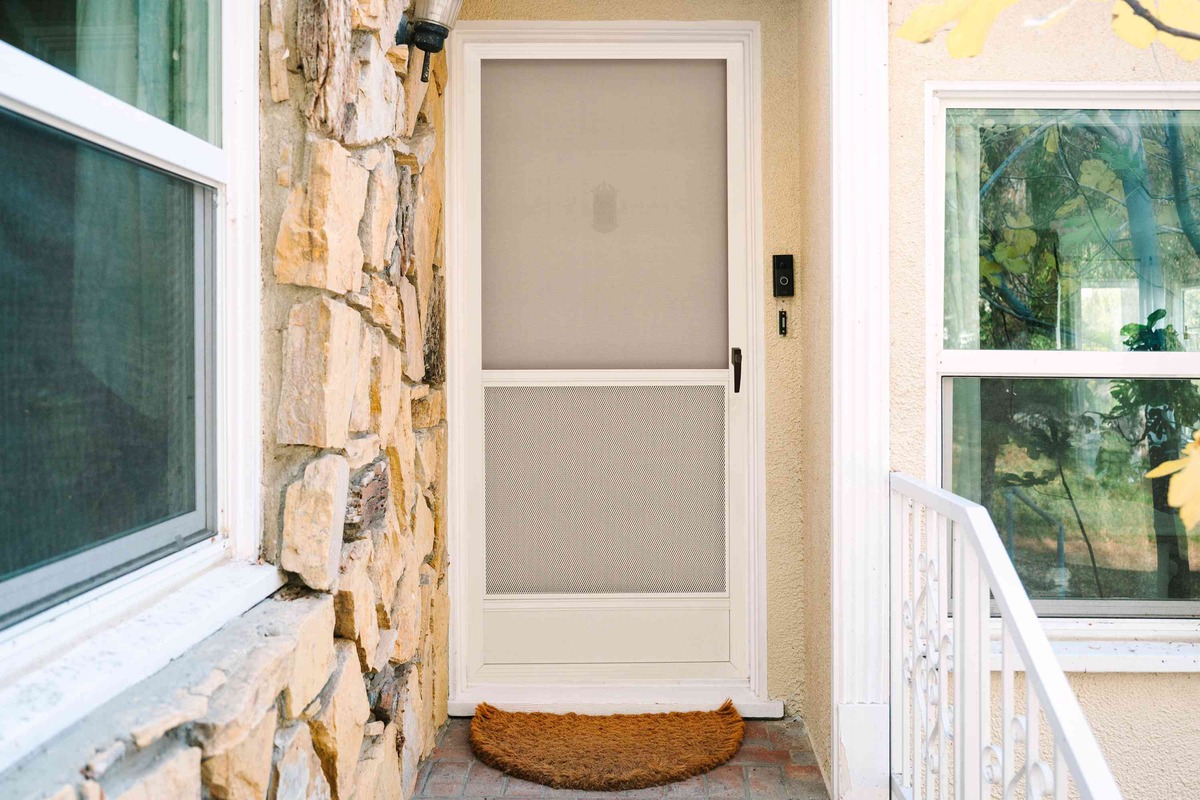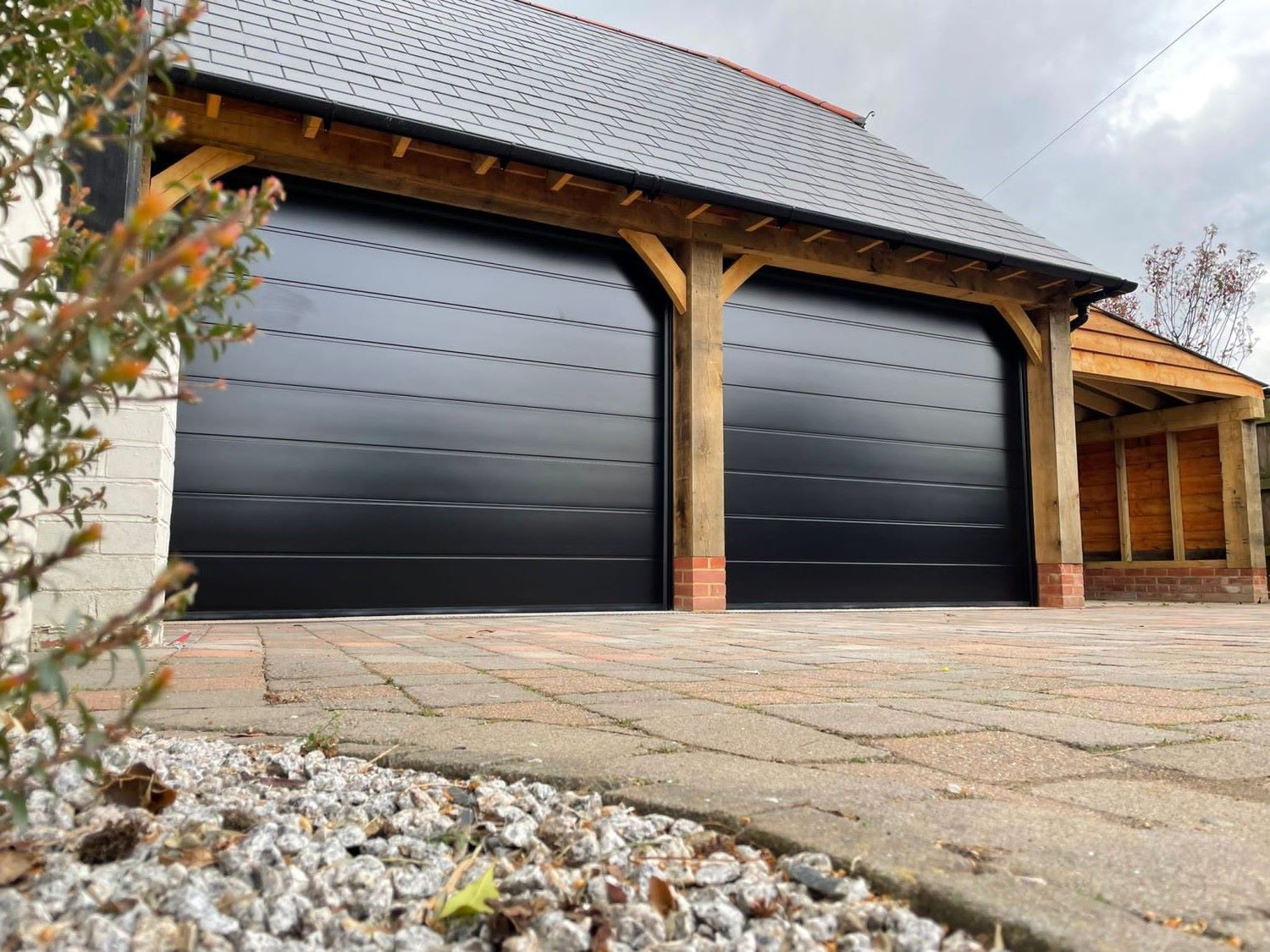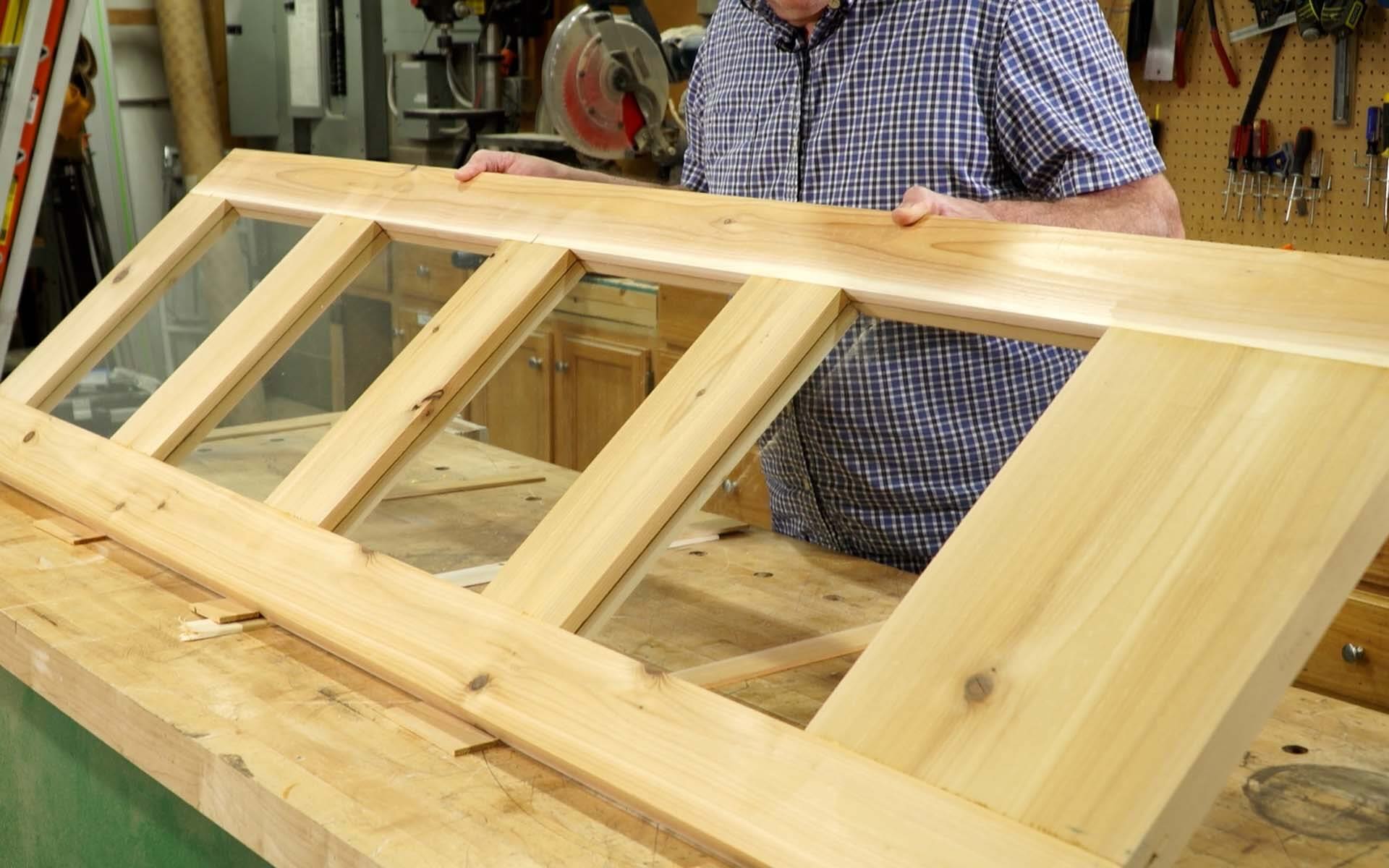Home>Home & Furniture>Doors & Windows>DIY Screen Door: Step-by-Step Guide To Building Your Own


Doors & Windows
DIY Screen Door: Step-by-Step Guide To Building Your Own
Published: February 20, 2024
Editor-in-Chief with a decade in home renovation and a passion for vintage furniture. Diane is known for her weekend treasure hunts at flea markets, enriching our content with unique style insights.
Learn how to build your own DIY screen door with our step-by-step guide. Perfect for doors & windows projects. Start creating today!
(Many of the links in this article redirect to a specific reviewed product. Your purchase of these products through affiliate links helps to generate commission for Twigandthistle.com, at no extra cost. Learn more)
Introduction
Are you looking to add a personal touch to your home while keeping pesky insects at bay? Building your own DIY screen door is a rewarding and practical project that allows you to customize the door to fit your specific needs and style. Whether you're a seasoned DIY enthusiast or a novice looking for a fulfilling project, constructing a screen door can be a satisfying endeavor that enhances both the aesthetic and functionality of your home.
By crafting your own screen door, you have the freedom to choose the materials, design, and dimensions that best suit your space. This project not only provides a sense of accomplishment but also allows you to tailor the door to complement the existing decor of your home. Additionally, a DIY screen door can be a cost-effective alternative to purchasing a pre-made door, saving you money while adding a personal touch to your living space.
Building a screen door from scratch also offers the opportunity to engage in a hands-on, creative process that can be both educational and enjoyable. Whether you're working alone or involving family members in the project, constructing a screen door can be a bonding experience that fosters a sense of pride and ownership in your home.
Throughout this step-by-step guide, you'll learn how to measure and cut the frame, assemble the door, install the screen, add hinges and handles, and finally, install the door. With the right materials and tools, along with a willingness to embrace a DIY spirit, you can embark on this fulfilling journey to create a custom screen door that not only keeps insects out but also adds a touch of personality to your home. Let's dive into the materials and tools you'll need to get started on this exciting project.
Read more: How to Build a DIY Garage Door Screen
Materials Needed
To embark on the fulfilling journey of building your own DIY screen door, you'll need a selection of materials that will form the foundation of your project. Here's a comprehensive list of the essential materials required to construct a custom screen door:
-
Wood: Select high-quality wood for the frame of the screen door. Opt for a durable and weather-resistant wood species such as cedar, redwood, or cypress. The wood should be sturdy enough to withstand outdoor elements and frequent use.
-
Screen Material: Choose a screen material that suits your specific needs. Options include traditional fiberglass mesh, durable aluminum screen, or pet-resistant screen for households with furry companions. Consider the visibility, durability, and maintenance requirements of each material before making your selection.
-
Wood Screws: Invest in high-quality wood screws to secure the frame and components of the screen door. Ensure that the screws are suitable for outdoor use and capable of providing a strong and lasting hold.
-
Wood Glue: Opt for a reliable wood glue to reinforce the joints and connections within the frame. The wood glue will enhance the structural integrity of the screen door, providing added stability and longevity.
-
Hinges and Handles: Select hinges and handles that complement the design and functionality of your screen door. Choose durable hardware that can withstand frequent opening and closing while adding a touch of style to the finished door.
-
Finishing Materials: Depending on your design preferences, you may need paint, stain, or sealant to finish the screen door. These materials will not only enhance the visual appeal of the door but also provide protection against the elements.
-
Sandpaper and Wood Filler: Prepare the wood for finishing by having sandpaper and wood filler on hand. These materials will help smooth out imperfections and create a flawless surface for painting or staining.
-
Measuring Tape and Square: Accurate measurements are crucial for ensuring a precise fit and proper alignment of the screen door. A measuring tape and square will aid in achieving the necessary dimensions for the frame and components.
-
Safety Equipment: Prioritize safety by having protective gear such as safety goggles, gloves, and a dust mask. These items will safeguard you during the construction process, especially when cutting and sanding wood.
By gathering these essential materials, you'll be well-equipped to commence the construction of your DIY screen door. With the materials in hand, the next step is to prepare the necessary tools for this engaging project.
Tools Needed
Embarking on the construction of a DIY screen door requires a selection of essential tools to facilitate the assembly process and ensure precision in the construction. From measuring and cutting the frame to installing the screen and adding finishing touches, having the right tools at your disposal is crucial for a successful and satisfying outcome. Here's a comprehensive list of the tools needed to undertake the construction of your custom screen door:
-
Circular Saw: A reliable circular saw is indispensable for accurately cutting the wood components of the screen door. Whether you're cutting the frame pieces or trimming the screen material to size, a circular saw provides the necessary precision and efficiency.
-
Miter Saw: For achieving precise angled cuts, a miter saw is an invaluable tool. It allows for clean and accurate cutting of the frame components, ensuring seamless joints and a professional finish.
-
Drill and Bits: A power drill equipped with a selection of drill bits is essential for creating pilot holes and driving screws during the assembly process. Choose high-quality drill bits suitable for wood to ensure smooth and accurate drilling.
-
Screwdriver Set: While a power drill is essential, a set of screwdrivers, including Phillips and flat-head varieties, is also necessary for certain assembly tasks. Having a range of screwdriver sizes ensures compatibility with different screw types and sizes.
-
Clamps: Utilize clamps to secure the frame components during assembly, ensuring stability and alignment. Clamps are instrumental in holding the pieces in place while you drill, glue, or fasten them together, resulting in a sturdy and well-constructed frame.
-
Screen Installation Tools: Specific tools designed for installing screen material, such as a screen rolling tool and spline roller, are essential for achieving a professional and secure screen installation. These tools aid in evenly tensioning the screen and securing it within the frame.
-
Level: Maintaining the levelness of the screen door throughout the construction process is crucial for ensuring proper alignment and functionality. A reliable level allows you to confirm that the door is plumb and square at each stage of assembly.
-
Sanding Block or Orbital Sander: Prepare the wood surfaces for finishing by utilizing a sanding block or orbital sander. These tools facilitate the smoothing of rough edges and the refinement of the wood's surface, creating a perfect canvas for painting, staining, or sealing.
-
Utility Knife: A sharp utility knife is essential for trimming excess screen material and making precise cuts during the screen installation process. It enables you to achieve clean and accurate edges for a polished final result.
-
Safety Gear: Prioritize safety by equipping yourself with essential safety gear, including safety goggles, gloves, and a dust mask. These items protect you from potential hazards during the construction process, ensuring a safe and secure working environment.
By ensuring that these essential tools are readily available, you'll be well-prepared to embark on the construction of your DIY screen door. With the right materials and tools at your disposal, you can confidently proceed to the next steps of measuring and cutting the frame, assembling the door, and bringing your custom screen door to life.
Step 1: Measure and Cut the Frame
The initial step in constructing your DIY screen door involves accurately measuring and cutting the frame components to lay the foundation for the door's structure. Precision is paramount at this stage, as it sets the stage for a well-fitted and visually appealing screen door. Here's a detailed guide to successfully completing this crucial step:
Gather the Necessary Materials and Tools
Before commencing the measuring and cutting process, ensure that you have the required materials, including high-quality wood, measuring tape, square, circular saw, and safety equipment. Having these essentials at hand will facilitate a smooth and efficient workflow while prioritizing safety throughout the process.
Read more: How to Build a DIY Magnetic Screen Door
Take Accurate Measurements
Begin by measuring the dimensions of the door opening to determine the required size of the frame. Use a measuring tape to record the height and width of the opening, ensuring precision in your measurements. Additionally, consider the depth of the door jamb to determine the appropriate thickness for the frame components.
Mark and Cut the Frame Pieces
With the measurements in hand, transfer the dimensions to the selected wood material, marking the locations for cuts with a pencil or marking tool. Use a square to ensure that the markings are perpendicular and accurate, maintaining the integrity of the frame components. Once marked, carefully use a circular saw to make precise cuts, following the marked lines to create the individual pieces of the frame.
Verify the Fit and Alignment
After cutting the frame pieces, verify their fit within the door opening to ensure that they align perfectly and accommodate any necessary adjustments. Use a level to confirm that the frame components are plumb and square, making any modifications as needed to achieve an optimal fit.
Prepare for Assembly
Once the frame pieces are accurately cut and verified for fit and alignment, prepare them for the assembly process by ensuring that the edges are smooth and free from imperfections. Use sandpaper or a sander to refine the edges, creating a flawless surface for the subsequent assembly and finishing stages.
By meticulously measuring and cutting the frame components with precision and attention to detail, you establish a solid groundwork for the construction of your custom screen door. This foundational step sets the stage for the subsequent assembly process, bringing you closer to the realization of your personalized and functional screen door.
Read more: DIY Screen Door Grill Ideas
Step 2: Assemble the Frame
With the frame components accurately measured and cut, the next pivotal phase in constructing your DIY screen door involves the meticulous assembly of the frame. This step is crucial in ensuring the structural integrity and stability of the door, laying the groundwork for the subsequent installation of the screen and hardware. Here's a comprehensive guide to successfully assembling the frame of your custom screen door:
Gather the Necessary Materials and Tools
Before commencing the assembly process, gather the essential materials and tools required for this phase. Ensure that you have the frame components, wood glue, wood screws, clamps, drill, and screwdriver set readily available. Additionally, prioritize safety by wearing protective gear, including safety goggles and gloves, to safeguard yourself during the assembly process.
Arrange the Frame Components
Lay out the frame components in the designated assembly area, organizing them in the sequence required for assembly. This preparatory step ensures a streamlined and efficient workflow, allowing you to access the necessary pieces without interruption during the assembly process.
Apply Wood Glue and Secure with Screws
Begin the assembly process by applying a generous amount of high-quality wood glue to the joints of the frame components. The wood glue enhances the strength and durability of the connections, providing added stability to the frame. Once the glue is applied, use wood screws to securely fasten the joints, ensuring a tight and reliable bond between the frame pieces.
Read more: How to Build a Retractable Screen Door
Utilize Clamps for Stability
As you join the frame components and apply wood glue, utilize clamps to hold the pieces in place, maintaining stability and alignment during the assembly process. The clamps prevent the components from shifting or misaligning, ensuring that the frame is constructed with precision and accuracy.
Confirm Alignment and Squareness
Throughout the assembly process, periodically verify the alignment and squareness of the frame using a reliable square and level. Confirm that the frame is perfectly square and the joints are aligned, making any necessary adjustments to achieve optimal precision and uniformity.
Allow for Proper Drying and Curing
After completing the assembly of the frame, allow sufficient time for the wood glue to dry and cure, ensuring that the connections achieve maximum strength and stability. Follow the manufacturer's recommendations for the drying time of the wood glue, prioritizing patience to guarantee the integrity of the assembled frame.
By meticulously following these steps, you can successfully assemble the frame of your DIY screen door, laying the foundation for the subsequent stages of installing the screen, adding hinges and handles, and ultimately installing the door. This pivotal phase brings you closer to the realization of your custom screen door, reflecting your craftsmanship and attention to detail.
Step 3: Install the Screen
With the frame of your DIY screen door expertly assembled, the next critical phase involves the precise installation of the screen material. This step not only serves the functional purpose of keeping insects at bay but also contributes to the visual appeal of the door. Here's a detailed guide to successfully installing the screen on your custom screen door:
Gather the Necessary Materials and Tools
Before commencing the screen installation process, ensure that you have the essential materials and tools readily available. You will need the screen material of your choice, screen rolling tool, spline roller, utility knife, and a flat, stable work surface. Additionally, have the frame of the screen door prepared and positioned in a suitable workspace to facilitate a smooth and efficient installation process.
Prepare the Screen Material
Lay the screen material over the frame, ensuring that it overlaps the edges by a sufficient margin to accommodate the installation process. Smooth out the screen material to remove any wrinkles or creases, ensuring a taut and even surface for installation. Secure the screen in place using clamps or weights, preventing it from shifting during the installation.
Install the Spline
Begin the installation process by inserting the spline, a flexible cord-like material, into the groove around the perimeter of the frame. Use a spline roller to press the spline into the groove, securing the screen material in place. Work methodically around the frame, gradually inserting the spline and ensuring that the screen remains taut and free from slack.
Trim Excess Screen Material
Once the spline is securely in place, use a utility knife to trim the excess screen material along the outer edge of the frame. Exercise caution and precision during this step, ensuring clean and accurate cuts to achieve a polished and professional finish. Remove any residual screen material to create a neat and seamless appearance.
Read more: DIY Screen Door Protector Ideas
Verify Tension and Alignment
After trimming the excess screen material, verify the tension and alignment of the installed screen. Ensure that the screen is uniformly taut across the frame, free from sagging or unevenness. Gently press on the screen to confirm its resilience and stability, making any necessary adjustments to achieve optimal tension and alignment.
Final Inspection
Conduct a thorough inspection of the installed screen, confirming that it is securely held in place by the spline and exhibiting a smooth and uniform appearance. Address any minor imperfections or irregularities, ensuring that the screen is flawlessly installed and ready for the subsequent stages of adding hinges, handles, and ultimately installing the door.
By meticulously following these steps, you can successfully install the screen on your DIY screen door, achieving a functional and visually appealing barrier against insects while adding a personalized touch to your home. This pivotal phase brings you closer to the completion of your custom screen door, reflecting your craftsmanship and attention to detail.
Step 4: Add Hinges and Handles
With the frame assembled and the screen securely installed, the next crucial step in the construction of your DIY screen door involves the addition of hinges and handles. This phase not only facilitates the functionality of the door but also contributes to its aesthetic appeal, providing the finishing touches that bring the project to completion. Here's a detailed guide to successfully adding hinges and handles to your custom screen door:
Gather the Necessary Materials and Tools
Before commencing the installation of hinges and handles, ensure that you have the essential materials and tools readily available. You will need hinges, handles, screws compatible with the chosen hardware, a power drill, screwdriver set, and a measuring tape. Additionally, have the prepared screen door positioned in a suitable workspace to facilitate a smooth and efficient installation process.
Read more: How to Make DIY Window Screens
Determine Hinge and Handle Placement
Begin by determining the placement of the hinges and handles on the screen door. Position the hinges on the side of the door that will be attached to the door frame, ensuring that they are evenly spaced and aligned for proper functionality. Similarly, determine the ideal placement for the handles, considering both aesthetic appeal and ergonomic usability.
Mark and Pre-Drill Screw Holes
Once the placement of the hinges and handles is determined, mark the locations for the screw holes using a pencil or marking tool. Prior to attaching the hinges and handles, pre-drill the screw holes to prevent the wood from splitting and to facilitate the smooth insertion of the screws. Use a drill bit that matches the size of the screws to ensure precise and secure attachment.
Attach the Hinges and Handles
With the screw holes pre-drilled, proceed to attach the hinges and handles to the screen door using the appropriate screws. Utilize a power drill or screwdriver set to securely fasten the hardware, ensuring that the hinges are aligned and the handles are firmly attached. Exercise caution and precision during this step to achieve a professional and reliable installation.
Verify Functionality and Alignment
After attaching the hinges and handles, verify the functionality and alignment of the hardware. Open and close the screen door to confirm that the hinges operate smoothly and support the weight of the door. Similarly, test the handles to ensure that they provide a comfortable grip and facilitate effortless operation. Make any necessary adjustments to achieve optimal functionality and alignment.
Final Inspection
Conduct a thorough inspection of the installed hinges and handles, confirming that they are securely attached and contribute to the overall functionality and visual appeal of the screen door. Address any minor imperfections or misalignments, ensuring that the hardware is flawlessly installed and ready for the final phase of installing the door.
By meticulously following these steps, you can successfully add hinges and handles to your DIY screen door, enhancing its functionality and visual appeal while bringing the project one step closer to completion. This pivotal phase reflects your attention to detail and craftsmanship, culminating in the realization of a personalized and functional screen door tailored to your specific needs and style.
Step 5: Install the Door
With the frame assembled, the screen securely installed, and the hinges and handles in place, the final and gratifying phase of constructing your DIY screen door involves the installation of the door itself. This pivotal step brings the project to completion, culminating in the realization of a personalized and functional screen door that reflects your craftsmanship and attention to detail. Here's a detailed guide to successfully installing the door on your custom screen door:
Prepare the Door Opening
Before proceeding with the installation, ensure that the door opening is clean, free from debris, and adequately prepared to accommodate the screen door. Remove any obstructions or protrusions that may hinder the installation process, ensuring a clear and unobstructed pathway for the door.
Position the Screen Door
Carefully position the prepared screen door at the entrance, ensuring that it aligns with the door opening and is centered within the frame. Enlist the assistance of a partner if needed to support the door and facilitate a smooth and controlled installation process.
Read more: DIY Fly Screen Door: Step-by-Step Guide
Secure the Door with Hinges
With the door positioned in the opening, align the hinges on the screen door with the corresponding hinge locations on the door frame. Securely attach the hinges, ensuring that they are firmly fastened and capable of supporting the weight of the door. Verify that the door swings open and closes smoothly, making any necessary adjustments to achieve optimal functionality.
Test the Operation
After securing the door with hinges, test its operation to confirm that it opens and closes seamlessly within the door frame. Check for any resistance or misalignment, addressing any issues to ensure that the door functions flawlessly. Verify that the door latches securely when closed, providing a reliable barrier while maintaining ease of operation.
Final Adjustments
Conduct a comprehensive inspection of the installed door, addressing any minor adjustments or alignments to achieve a perfect fit and operation. Confirm that the door is plumb and square within the frame, ensuring that it complements the overall aesthetic and functionality of the entrance.
By meticulously following these steps, you can successfully install the door on your DIY screen door, bringing the project to completion and realizing a personalized and functional addition to your home. This pivotal phase reflects your dedication and skill, resulting in a custom screen door that enhances both the aesthetic appeal and practicality of your living space.
Conclusion
Embarking on the journey of building your own DIY screen door has been a fulfilling and rewarding endeavor, culminating in the creation of a personalized and functional addition to your home. Throughout this step-by-step guide, you have meticulously measured and cut the frame, assembled the door, installed the screen, added hinges and handles, and ultimately installed the door. Each phase of the construction process has been a testament to your craftsmanship, attention to detail, and dedication to creating a custom screen door that reflects your unique style and preferences.
As you stand back and admire the completed DIY screen door, you can take pride in the fact that you have not only crafted a practical barrier against insects but also added a touch of personality and creativity to your living space. The process of building the screen door has been an educational and enjoyable experience, allowing you to engage in a hands-on project that fosters a sense of accomplishment and ownership.
Beyond the tangible outcome of the screen door itself, the journey of construction has provided an opportunity for bonding and collaboration, whether you embarked on the project alone or involved family members in the process. The shared moments of measuring, cutting, assembling, and installing have created lasting memories and strengthened the sense of pride in your home.
Furthermore, the DIY approach to constructing a screen door has empowered you to tailor the door to your specific needs and design preferences, offering a level of customization that is not readily available with pre-made doors. By selecting high-quality materials, choosing a design that complements your home, and investing your time and effort, you have created a screen door that is truly one-of-a-kind.
As you enjoy the functionality and visual appeal of your custom screen door, you can take satisfaction in the fact that you have not only saved on costs by opting for a DIY approach but have also honed your skills and creativity in the process. The completion of this project marks a significant achievement and serves as a constant reminder of your ability to transform raw materials into a practical and aesthetically pleasing addition to your home.
In conclusion, the construction of your DIY screen door has been a journey of creativity, craftsmanship, and fulfillment, resulting in a tangible creation that enhances the ambiance and functionality of your living space. The door stands as a testament to your dedication and ingenuity, embodying the spirit of DIY craftsmanship and personalization. As you continue to enjoy the benefits of your custom screen door, may it serve as a reminder of the satisfaction and pride that come with embracing a hands-on approach to home improvement.








